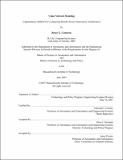Value network modeling : a quantitative method for comparing benefit across exploration architectures
Author(s)
Cameron, Bruce G. (Bruce Gregory)
DownloadFull printable version (7.824Mb)
Other Contributors
Massachusetts Institute of Technology. Technology and Policy Program.
Advisor
Edward F. Crawley.
Terms of use
Metadata
Show full item recordAbstract
In the design of complex systems serving a broad group of stakeholders, it can be difficult to prioritize objectives for the architecture. I postulate that it is possible to make architectural decisions based on consideration of stakeholder value delivery, in order to help prioritize objectives. I introduce the concept of value network models to map out the indirect benefit delivered to stakeholders. A numerical methodology for prioritizing paths through this network model is presented, with a view to discovering the most important organizational outputs. I show how value network models can be linked to architecture models to provide decision support to the architect. I present a case study to examine the connectivity and sensitivity of a test architecture to value delivery. I conclude that a limited subset of NASA's outputs will discriminate between architectures. In this manner, I show how value considerations can be used to structure the design space before critical technical decisions are made to narrow it. A number of organizational implications for value delivery are generated from this analysis. In particular, I show that benefit flows should be aligned to organizational processes and responsibilities, and that failure to map stakeholder input to architecture evaluation can weaken benefit.
Description
Thesis (S.M.)--Massachusetts Institute of Technology, Dept. of Aeronautics and Astronautics; and, (S.M.)--Massachusetts Institute of Technology, Engineering Systems Division, Technology and Policy Program, 2007. This electronic version was submitted by the student author. The certified thesis is available in the Institute Archives and Special Collections. Includes bibliographical references (p. 167-170).
Date issued
2007Department
Massachusetts Institute of Technology. Department of Aeronautics and Astronautics; Massachusetts Institute of Technology. Engineering Systems Division; Technology and Policy ProgramPublisher
Massachusetts Institute of Technology
Keywords
Aeronautics and Astronautics., Technology and Policy Program.